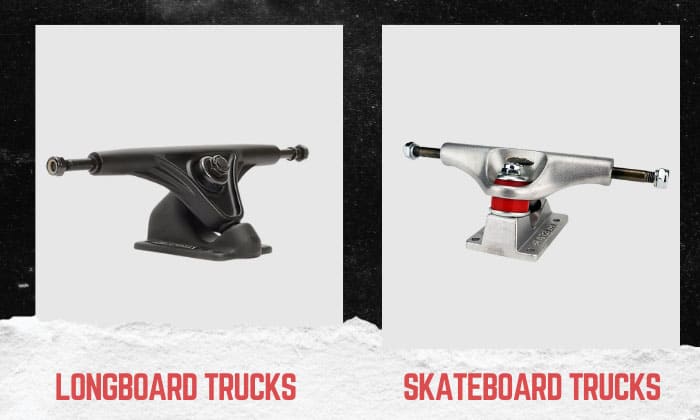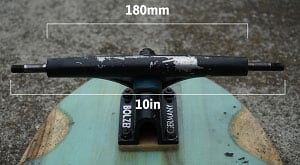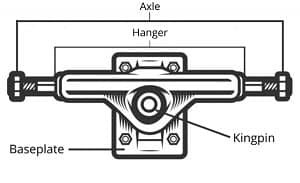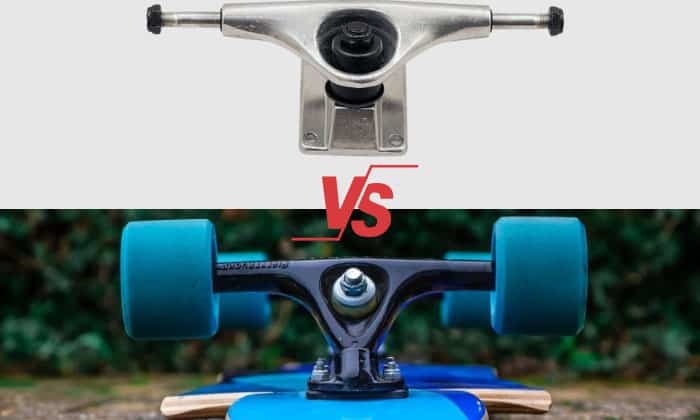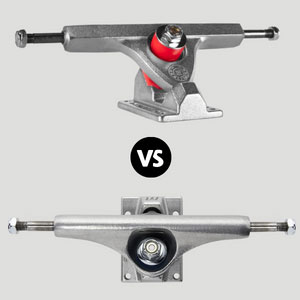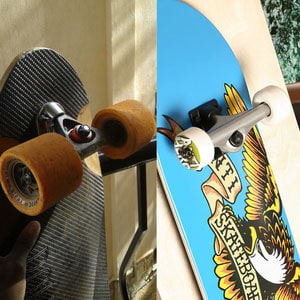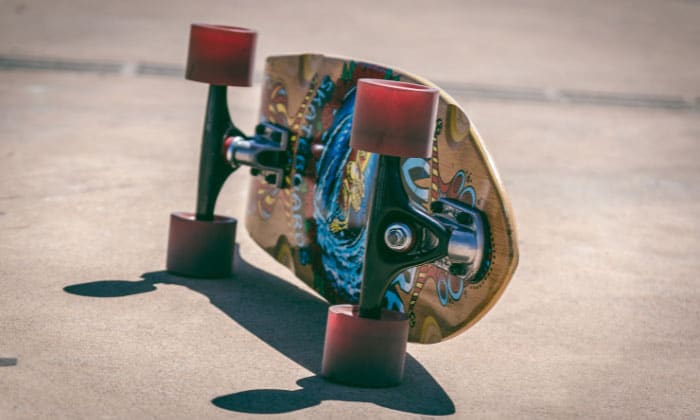Different types of boards make up a skate shop. Note that not all the boards you see there are skateboards. Some are cruisers, surfskates, and longboards. And when choosing one over the rest, consider the differences in configuration.
Let’s take longboard VS skateboard trucks, for example. The board’s performance heavily relies on these components. They could be tight, loose, durable, flimsy, or whatnot.
Hence, keep reading this article as we dig deeper into this comparison of an integral part on two board types. From there, we’ll know the correct components to install.
| Parameter of Comparison | Longboard trucks | Skateboard trucks |
| Baseplate angles | 48° to 50°, perfect for downhill skating | 40° to 45°, yielding grippy and stable skate rides |
| Bushings | More versatile bushing usage depending on the riding style | Almost always work best with stiff bushings |
| Kingpin position | Facing out for an improved board responsiveness | Facing inward for a better control of the skateboard |
| Hanger width | 150mm to 180mm | 100m to 145mm |
| Axle width | Often the same as the deck’s width | Slightly smaller than the deck’s width for added maneuverability |
| Material composition | Brass and aluminum | Steel and aluminum |
Table of Contents
Skateboard VS Longboard trucks: Defined
At first glance, longboard and skate trucks might look the same due to their essential parts like kingpins and axles. However, we should take a better look at them.
1. Longboard trucks
Most, if not all, skateboarders already know the rule of skate trucks matching the deck’s width for an essential purpose. And the same concept applies to longboards.
Longboards, given their spacious decks, also need big longboard truck sizes. On average, these parts span from 150mm to 180mm in width.
Besides the truck dimensions, another unique aspect of longboard trucks is their kingpins’ positions. Many skaters have accustomed themselves to these bolts facing inwards. But with longboards, these thick pins face outward. And that is why people call these trucks Reverse Kingpin or RKP.
2. Skateboard trucks
Like different types of longboard trucks, skateboard trucks have the same elements in the form of axles, baseplates, kingpins, hangers, and bushings.
Having these trucks measured, we find skateboards on the narrower end because of the deck sizes. In a truck size chart, these wheel holders have axle sizes ranging from 6″ to 10″. Other than size, skate trucks also have three height levels: low, mid, and high.
Most brands produce skate trucks composed of aluminum and steel. Others invest in titanium.
Differences Between Skateboard and Longboard Trucks
You might now have an idea of how these truck types differ. But let’s get into the details and distinguish longboarding VS skateboarding trucks based on common criteria.
1. Baseplate
Without spacers, the baseplate is the part closest to the deck. We’ll start from here.
The baseplate holds the rest of the truck’s parts. Some may think this part has the same angle throughout, but it does not. And such an aspect distinguishes baseplates for skateboards and longboards.
Longboard trucks often have an angle ranging from 48° to 50°. These numbers indicate that the wheel holder works best for what longboards are for: downhill skating and carving.
On the other hand, skateboard truck baseplate angles only go around 40° to 45°. And such a configuration allows skaters to stabilize better at high speeds, though the turning will be less sharp.
2. Bushings
Bushings do not sit in just one place in a truck installation process. It’s between parts. Do these parts also vary in skateboards and longboards? Yes!
Like longboard wheels VS skateboard wheels, bushings have hardness levels.
Stiff bushings are more common on skateboards. Why? These parts assist the truck in stabilizing the skater.
Meanwhile, longboards are more versatile in this area, depending on the riding style. Riders who do downhill skating would use the same bushing hardness as skateboards.
A mid-softness level suits cruising longboards well. Ultimately, the softest in the scale are for carving.
3. Kingpin
We briefly talked about kingpins and their placement on the skateboard’s trucks. Now, how are longboards and skateboards different in this part?
Longboard trucks are Reverse Kingpin or RKP. This truck type finds the bolt angled outward or toward the tail or nose end of the deck.
RKP trucks have a taller height. And such a feature makes the longboard responsive, especially when skating slowly. Essentially, this kind of truck setup makes carving and downhill rides better.
If RKPs are responsive, the Traditional Kingpin trucks allow better control. And these wheel holders are almost always present in skateboards.
TKPs and other types of skateboard trucks are lower in height. Nonetheless, these trucks have all it takes for a skateboard to fit technical skating.
4. Hanger
Perhaps, the hanger holds almost all the components of the skateboard’s wheel system. And like the other parts, these also vary for skateboards and longboards, but only in width.
Skateboard truck hangers only range from 100mm to 145mm. Meanwhile, wide longboard trucks are beyond this scale with a 150mm to 180mm range. Hence, longboard hangers are less stable but slide more smoothly.
5. Axle
Axles are like the tips of the truck. These are where the wheels slide against and spin.
Deliberately, axles will vary in width the same way as the hangers. So, how do we choose the correct axle size, then?
The rule for longboards is simple. All we need is to ensure that the tips of the axle pins align with the sides of the longboard deck. And what do we achieve if we do that? We get stable longboard rides.
What about skateboard axles? One difference between a longboard compared to skateboard is that the latter has axle lengths shorter than the deck’s width. It’s slightly unorthodox, considering the concept of truck widths. But in effect, this configuration yields optimum control, a factor in successful technical skating.
6. Materials
In parts like trucks, we always aim for durability. However, some do not possess this attribute because of skateboard trucks material composition.
Depending on the purpose of the truck, the material varies. For sturdy longboard downhill skateboard trucks, manufacturers often use brass with a touch of aluminum.
Skateboards also use aluminum, but only on the hanger and baseplate. The axles are often of steel. Skateboard trucks are often lighter as well and more suitable for grinds.
Besides durability, remember, the skater’s comfort could also be a consideration. Hence, some brands invest in making hollow trucks to make their products lighter.
Pros and Cons
- Allows balanced rides
- Ideal for beginner skaters
- Better grinding space
- Slightly lower maneuverability because of the axle width
- Perfect for parks and other forms of technical skating
- Optimum control and maneuverability with narrow axles
- Slightly challenging to balance
- Some swerve issues from stiff bushings
Frequently Asked Questions
Can you use skateboard trucks on a longboard?
Is a skateboard with longboard trucks feasible? Because of the sizing difference, interchanging skateboard and longboard trucks won’t give quality results.
Imagine purchasing a skateboard and installing it with used longboard trucks. Not only does the axles’ size limit your maneuverability, but the setup could also impose some safety risks.
Why do longboards have the trucks backward?
Avid skateboard users will more likely find RKP trucks unusual. But why do longboards have their trucks made this way?
The backward position of RKPs makes the longboard more stable. Others say such a setup also prevents speed wobbles. And yet, these are only a few benefits of RKP trucks.
Do all longboard trucks fit all decks?
No. The only time skateboard and longboard trucks fit their respective decks is when they abide by the sizing concept we have discussed.
Hence, skateboards should ideally have narrower trucks. And longboards need those with axle pin lengths matching the deck width. Only then can both boards work at their optimum level.
Conclusion
Skateboards and longboards excel in their own right. And the only time they fail is when we mismatch their setups. Hence, we should always learn how these boards work and what configurations suit them.
With this longboard VS skateboard trucks comparison, we already knew that these wheel holders are not interchangeable. Also, they have different designs and sub-parts, making them best suited for specific purposes.
Remember, longboard trucks are for longboards only. And the same is appropriate with skateboards.

Hi, I am Charles Harris. I opened this site to write as much as I can about my biggest passion – skateboarding!
I started as a clumsy yet passionate rookie 10 years ago to now a still passionate yet much better skateboarder! But I have to tell you, the whole journey has always been fun and rewarding, indeed not without hardship.


